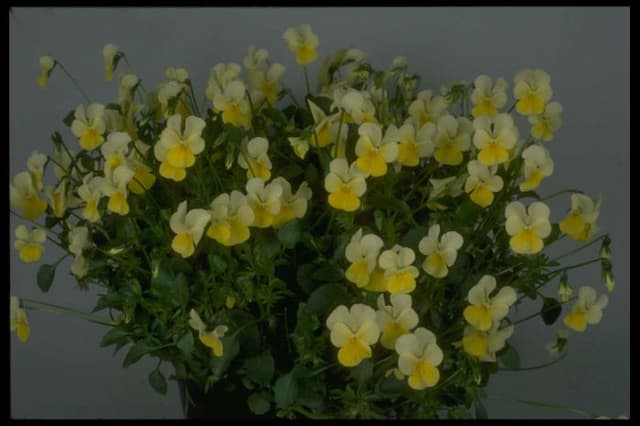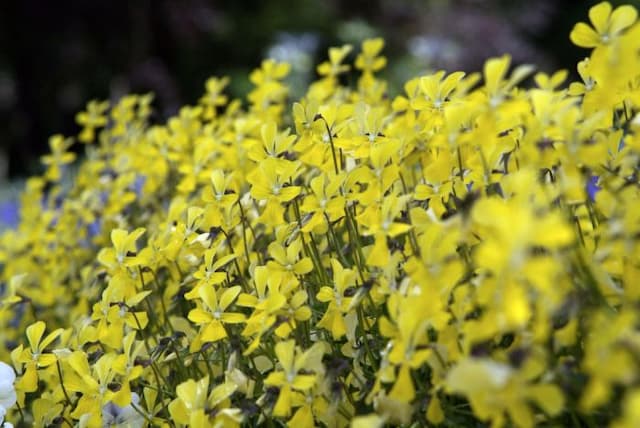Common Blue Violet Viola sororia 'Freckles' (Vt)

ABOUT
The Viola sororia 'Freckles' is a charming perennial plant known for its distinctive flowers. Resembling the classic common violet in form, the 'Freckles' variety stands out due to the unique speckling on its petals. The flowers are predominantly a soft purple or lilac color, but they are finely sprinkled with darker purple to nearly black freckles, giving them a spotted appearance that is quite eye-catching. The petals have a rounded shape, and the lower petal often showcases a slight white to cream coloration, which provides a striking contrast that makes the speckles even more noticeable. This beautiful flowering plant's foliage is typically heart-shaped, with a deep green hue that complements the light purple flowers. The leaves are often glossy and have a rich, velvety texture, which adds to the overall attractiveness of the plant. In some conditions, the foliage might take on a slightly serrated edge, giving it a delicate and ornate appearance. Generally, the plants have a low-growing and clumping habit, forming dense mounds of foliage that serve as a lush backdrop to the showy flowers which bloom prolifically in the right conditions.
About this plant
 Names
NamesFamily
Violaceae.
Synonyms
Common Blue Violet, Woolly Blue Violet, Hooded Violet, Florida Violet, Sororia Violet.
Common names
Viola sororia.
 Toxicity
ToxicityTo humans
The common blue violet (Viola sororia 'Freckles') is not considered highly toxic to humans. This plant is often regarded as safe, and some parts are even edible and used in culinary applications. However, it's always important to exercise caution and not consume any part of a plant unless you are certain of its safety and identification. While there are no well-documented cases of poisoning from the common blue violet, it is always possible for individuals to have allergies or sensitivities to plant compounds. In such cases, ingesting the plant could potentially lead to mild gastrointestinal upset or allergic reactions.
To pets
The common blue violet (Viola sororia 'Freckles') is generally considered non-toxic to pets, including dogs and cats. It is not known to contain any compounds that are harmful to pets. Therefore, ingestion of this plant by pets is unlikely to cause any significant symptoms of poisoning. As with humans, some animals may have individual sensitivities, and consumption could theoretically lead to mild stomach discomfort, but this is not commonly reported. If a pet does consume a large quantity of the plant and shows signs of distress, it is advisable to consult a veterinarian.
 Characteristics
CharacteristicsLife cycle
Perennials
Foliage type
Deciduous
Color of leaves
Green
Flower color
Purple
Height
0.5 feet (15 cm)
Spread
1 feet (30 cm)
Plant type
Herb
Hardiness zones
Varies
Native area
North America
Benefits
 General Benefits
General Benefits- Attracts pollinators: Vt is known to attract butterflies and bees, which help in the pollination of nearby plants.
- Low maintenance: It is a hardy perennial that requires minimal care once established, making it an ideal plant for novice gardeners or those with limited time.
- Aesthetic appeal: With its distinctive purple flowers and speckled petals, Vt adds unique visual interest to gardens and landscapes.
- Erosion control: The plant's root system helps to stabilize the soil, preventing erosion in garden beds and naturalized areas.
- Habitat support: It provides food and habitat for various insects, contributing to biodiversity in the garden.
- Tolerance of various conditions: Vt can grow in a wide range of soil types and light conditions, from full sun to partial shade.
- Seasonal interest: It has a long flowering period in spring, which adds color to gardens at a time when many other plants are not yet in bloom.
- Native species: As a native species, it is particularly well-suited to regional climates and ecosystems, requiring less supplemental water and care once acclimated.
 Medical Properties
Medical Properties- Anti-inflammatory: Compounds within Viola sororia 'Freckles' may possess anti-inflammatory properties beneficial for reducing unwanted inflammation in the body.
- Expectorant: Traditionally, Viola sororia has been used to help loosen phlegm and facilitate a productive cough, aiding in the relief of respiratory conditions.
- Diuretic: The plant has been considered to increase urine production, potentially helping to relieve water retention and support kidney function.
- Antipyretic: There is a traditional belief that Viola sororia can help reduce fever, although such uses are not widely supported by scientific evidence.
- Emollient: The plant has been applied topically for its soothing effect on the skin, which might help with dry or irritated skin conditions.
 Air-purifying Qualities
Air-purifying QualitiesThis plant is not specifically known for air purifying qualities.
 Other Uses
Other Uses- The leaves of the common blue violet can be used as a natural dye for fabrics or food coloring, imparting a delicate greenish-blue hue.
- The flowers are edible and can be used to add color and a mild, floral flavor to salads, desserts, or as garnish on various dishes.
- Common blue violet petals can be crystallized with sugar and used as decorative sweets or to embellish cakes and pastries.
- The plant can be infused in syrups to create flavored beverages or cocktails with a unique, floral twist.
- Common blue violet can be processed into a natural ink for art or writing, offering a unique alternative to synthetic inks.
- Leaves and flowers may be used in potpourri for a light, earthy fragrance in your home.
- Pressed violet flowers can be used in papermaking to create beautiful, embedded designs in homemade papers.
- The plant's leaves and flowers serve as food for various larvae of butterfly and moth species, supporting local biodiversity.
- Common blue violet, when planted in gardens, can act as ground cover, preventing soil erosion and suppressing weed growth.
- The flowers can be used in homemade perfumes or scented sachets due to their gentle fragrance.
Interesting Facts
 Feng Shui
Feng ShuiThe Common Blue Violet is not used in Feng Shui practice.
 Zodiac Sign Compitability
Zodiac Sign CompitabilityThe Common Blue Violet is not used in astrology practice.
 Plant Symbolism
Plant Symbolism- Innocence: The Viola sororia 'Freckles', also known as the Common Blue Violet, often symbolizes innocence due to its delicate and dainty flowers.
- Modesty: With its tendency to grow low to the ground and its unassuming blooms, the Common Blue Violet is often associated with modesty and humility.
- Spiritual Wisdom: In some traditions, the deep blue or purple color of the violet is connected to spirituality and the pursuit of knowledge.
- Love: The heart-shaped leaves of violets have made them a symbol of love and faithfulness throughout history.
- Protection: Folklore sometimes regards violets as a talisman to ward off evil spirits, giving them a protective symbolism.
 Water
WaterTo properly water the common blue violet, water the plant when the top inch of soil feels dry to the touch. Typically, this means watering once every week, but this can vary depending on climate conditions and indoor environments. Provide enough water to moisten the soil thoroughly, using approximately one gallon over the span of a month during active growth periods. Ensure the container has drainage holes to prevent waterlogging, which can lead to root rot. During the winter, reduce watering frequency to match the plant's reduced growth rate.
 Light
LightThe common blue violet thrives in conditions that offer partial shade to filtered sunlight. Ideally, place the plant in a location where it can receive morning sunlight and afternoon shade, or bright, indirect light throughout the day. Avoid exposing the common blue violet to prolonged direct afternoon sunlight, as this can be too intense and may cause leaf scorch.
 Temperature
TemperatureThe common blue violet prefers cool to moderate temperatures, typically flourishing between 60 and 75 degrees Fahrenheit. It can tolerate temperatures as low as 40 degrees Fahrenheit and as high as 80 degrees Fahrenheit, but it's best to avoid extreme temperature variations. Protect the plant from drafts and sudden temperature changes to maintain its health and vitality.
 Pruning
PruningPruning the common blue violet is done primarily to remove spent flowers and damaged leaves, which encourages the plant to produce more blooms and maintain a compact shape. Prune immediately after the flowering season ends, typically in late spring or early summer. Cutting back the foliage by one-third can also promote bushier growth. Do not prune in the winter, as the plant is in a resting phase.
 Cleaning
CleaningAs needed
 Soil
SoilCommon blue violet (Viola sororia 'Freckles') thrives best in a soil mix composed of loamy, rich, and well-draining soil with added organic matter like compost. The ideal pH range for this plant is slightly acidic to neutral, about 6.0 to 7.0.
 Repotting
RepottingCommon blue violets should be repotted every 1-2 years to refresh the soil and accommodate growth, ideally done during the spring or fall.
 Humidity & Misting
Humidity & MistingCommon blue violets prefer moderate to high humidity levels, but they are quite adaptable to average household humidity conditions.
 Suitable locations
Suitable locationsIndoor
Place in bright, indirect light with moist soil.
Outdoor
Plant in partial shade with rich, moist soil.
Hardiness zone
3-9 USDA
 Life cycle
Life cycleThe life of the common blue violet (Viola sororia 'Freckles') begins as a seed that germinates in moist, fertile soil typically in early spring. The seedling develops into a rosette of heart-shaped leaves, and as it matures, it forms a compact, clumping habit. In spring and intermittently into fall, the plant produces distinctive white flowers with purple speckles on short stems just above the foliage. After pollination, often by bees, the flowers develop into seed capsules that eventually burst open to disperse seeds nearby. The common blue violet is a perennial, re-emerging from its rootstock after winter dormancy to start the cycle anew. It can also spread by rhizomes, gradually forming a dense ground cover over time.
 Propogation
PropogationPropogation time
Spring-Early Summer
Propogation: The most popular method for propagating the Common Blue Violet (Viola sororia 'Freckles') is through division. This is ideally done in the fall, although spring is also a suitable time. The process involves gently digging up an established violet plant and carefully separating the rhizomes or stolons with roots attached. Each division should have several leaves and a healthy section of roots. Once divided, the clumps can be planted immediately into a prepared garden bed or pot with well-draining soil, ideally in a location with partial shade to mimic their natural woodland habitat. After planting, it's important to water the divisions thoroughly to help establish them in their new locations.









